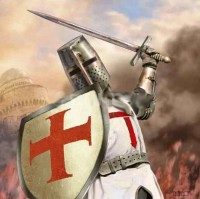Idolatry
Idolatry
It is a strange irony that those who reverence stones live in glass ideologies.
—L. Brown
Idolatry—every monotheist abhors the thought, and yet many commit the crime themselves. Few today fully grasp the complexities of this issue, for the definition of idolatry has been buried beneath nearly 1,700 years of church tradition.
The second commandment states, “You shall not make for yourself a carved image—any likeness of anything that is in heaven above, or that is in the earth beneath, or that is in the water under the earth; you shall not bow down to them nor serve them” (Exodus 20:4–5). Alternate translations employ slightly different, though significant, wording, as for example: “You shall not bow down to them or worship them” (NRSV, NIV).
The commandment not to make carved images speaks for itself, as does the subsequent decree not to make any likeness whatsoever.
These directives could not be clearer.
It is man’s nature, however, to seek loopholes in laws, taxes, and scripture. Consequently, there are those who consider the initial order not to make “carved images” or “any likeness of anything” conditional upon the following decree not to serve or worship the images—the argument being that if nobody actually worships the image itself, then it’s permissible to make it. But that’s not what the commandment says. And in any case, caution dictates avoiding what God has forbidden, for the one who trespasses can expect to be held accountable.
But let’s take a step backward. What do the words serve and worship really mean?
The verb to serve, according to Merriam-Webster’s Dictionary, means “to give the service and respect due to (a superior).”[i] Sooo, if placing images in exalted positions (statues of saints literally placed upon pedestals, religious icons framed, etc.), spending time, energy and money to dust, clean, beautify, and preserve them are not acts of service and respect, what are?
The typical Christian response? That these acts of service are not acts of worship.
Now, wait a minute. The word worship wasn’t even around two thousand years ago. In fact, it wasn’t around one thousand years ago. It didn’t exist in the English language during the period of revelation, even if the New Testament had been written in English, which it wasn’t. So what words were available in biblical times? What is the meaning from which the word worship was derived?
Not surprisingly, we trace the word worship back to a sense of having worth: a sense of worthiness:
Worship began life as a compound noun meaning virtually “worthiness.” It was formed from the adjective worth and the noun suffix ‑ship “state, condition,” and at first was used for “distinction, credit, dignity.” This soon passed into “respect, reverence,” but it was not used in specifically religious contexts until the 13th century. The verb dates from the 12th century.[ii]
And this from the New Catholic Encyclopedia:
Worship: In Anglo-Saxon, “weorð-scipe” meant “worth-ship,” in which “worth” is to be understood in the sense of value or honor. Worship, therefore, originally meant the state of worth, the quality of being valuable or worthy.[iii]
So what does the second commandment really say? Not only should one not bow or pray to man‑made images (in the manner of many Catholics), but one should not even value these images.
“But we don’t value them!” the average Christian responds.
Oh, really? Well, in that case, you won’t mind if we just toss them into the garbage or flush them down the toilet. I mean, they’re worthless, right? Without value, right? And what do we do with worthless things? We throw them away, don’t we?
The point is that, yes, Christians value their images, and in this manner they violate the second commandment.
Does idolatry manifest itself in other ways?
Sure. Ever wonder why people used to (and in some cases, still do) greet upper‑tier clergy, royalty, and members of the social elite as “Your worship?” By this phrase, commoners venerate men and women of high worth, position, and social status. So is that worship? According to the definition of the word, yes. “Your worship” meant “Your worthiness,” and conveyed the distinction of high value.
So does this mean the commoners who used this phrase worshipped those they addressed in such a manner? Uh, yes. Yup, that’s about it. Not only did they worship them, they idolized them, and we see this dynamic applied as much to music, sports, and movie stars in the present day as we do to clergy, royalty, and the social elite.
“Oh, come on,” you might say, “You’re being ridiculous.”
No, I’m being precise.
I’m not saying God has forbidden us to honor such individuals; I’m just saying that, yes, addressing individuals in such terms as “Your worship” is a form of worship. However, where this crosses the line into the forbidden zone is when people revere others as gods, or grant them the honor and respect reserved for our Creator. Should they prefer these individuals’ guidance to the laws and guidance of revelation, they usurp God’s authority. Likewise, should they revere such an individual by, oh let’s say, claiming him to be infallible or by bowing down to him (even if just to kiss his ring), they grant him the rights and special honor reserved for Almighty God.
In this manner, idolatry does not require a statue, although statues certainly heighten the offense. After all, “idolatry refers to the worship of gods other than the one, true God, and the use of images is characteristic of the life of the heathen.”[iv]
It is interesting to have a Catholic encyclopedia provide such a definition, isn’t it? Why, we don’t even need to read between the lines to realize it is self-condemning!
Unfortunately, many modern Christian denominations justify their practices more on the basis of tradition than scripture. Rarely is scripture given priority over tradition. Examples do exist, however. As recently as the 1500s, the Nestorian Christians of the Malabar Coast in India were presented with an image of the Virgin Mary for the first time. Largely sheltered from European influence, these Malabar Coast Christians had remained ignorant of the changes instituted by the various councils and synods of the European churches. Only with the establishment of sea routes in the sixteenth century did the two begin to interact. As Edward Gibbon noted,
Their separation from the Western world had left them in ignorance of the improvements or corruptions of a thousand years; and their conformity with the faith and practice of the fifth century, would equally disappoint the prejudices of a Papist or a Protestant.[v]
So how did they respond when presented with an image of the Virgin Mary?
The title of Mother of God was offensive to their ear, and they measured with scrupulous avarice the honours of the Virgin Mary, whom the superstition of the Latins had almost exalted to the rank of a goddess. When her image was first presented to the disciples of St. Thomas, they indignantly exclaimed, “We are Christians, not idolaters!”[vi]
It is worth noting that these Malabar Coast Christians were neither incorrect nor alone in their views:
The primitive Christians were possessed with an unconquerable repugnance to the use and abuse of images, and this aversion may be ascribed to their descent from the Jews, and their enmity to the Greeks. The Mosaic law had severely proscribed all representations of the Deity; and that precept was firmly established in the principles and practice of the chosen people. The wit of the Christian apologists was pointed against the foolish idolaters, who bowed before the workmanship of their own hands, the images of brass and marble, which, had they been endowed with sense and motion, should have started rather from the pedestal to adore the creative powers of the artist.[vii]
Or, to put it in simpler and more modern English,
The primitive Christians had attacked image worship as the work of the devil and there had been wholesale destruction of every type of idol when Christianity had at last triumphed. But over the succeeding centuries, the images crept back, appearing under new names but, to the critical eye, with an identical role. It was the Christians of the East who first began to feel that much of the pagan religion that their forefathers had destroyed, at such cost in martyrs’ blood, was insensibly being restored.[viii]
Religious art nonetheless was approved at the Council of Nicaea in 325 CE, and idol worship invaded Catholic services from that time on. Gibbon comments:
At first the experiment was made with caution and scruple; and the venerable pictures were discreetly allowed to instruct the ignorant, to awaken the cold, and to gratify the prejudices of the heathen proselytes. By a slow though inevitable progression, the honours of the original were transferred to the copy; the devout Christian prayed before the image of a saint; and the pagan rites of genuflexion, luminaries, and incense, again stole into the Catholic Church.[ix]
Given time (Gibbon continues),
The worship of images had stolen into the church by insensible degrees, and each petty step was pleasing to the superstitious mind, as productive of comfort and innocent of sin. But in the beginning of the eighth century, in the full magnitude of the abuse, the more timorous Greeks were awakened by an apprehension, that, under the mask of Christianity, they had restored the religion of their fathers; they heard, with grief and impatience, the name of idolaters; the incessant charge of the Jews and Mahometans, who derived from the law and the Koran an immortal hatred to graven images and all relative worship.[x]
All whose Christianity was based upon scripture, apostolic example, and the teachings of the prophets opposed the introduction of idol worship. Hence, when Emperor Constantine’s congruently named sister, Constantina, requested a representation of Jesus Christ in 326 CE, Eusebius of Nicomedia answered haughtily, “What, and what kind of likeness of Christ is there? Such images are forbidden by the second commandment.”[xi]
Over two centuries ago, Joseph Priestley penned a summary that not only explained the history, but also the reason for this corruption of Christian orthodoxy:
Temples being now built in honour of particular saints, and especially the martyrs, it was natural to ornament them with paintings and sculptures representing the great exploits of such saints and martyrs; and this was a circumstance that made the Christian churches still more like the heathen temples, which were also adorned with statues and pictures; and this also would tend to draw the ignorant multitude to the new worship, making the transition the easier.
Paulinus, a convert from paganism, a person of senatorial rank, celebrated for his parts and learning, and who died afterwards bishop of Nola in Italy, distinguished himself in this way. He rebuilt, in a splendid manner, his own episcopal church, dedicated to Felix the martyr, and in the porticoes of it, he had painted the miracles of Moses and of Christ, together with the acts of Felix and of other martyrs, whose relics were deposited in it. This, he says, was done with a design to draw the rude multitude, habituated to the profane rites of paganism, to a knowledge and good opinion of the Christian doctrine, by learning from those pictures what they were not capable of learning from books, of the lives and acts of Christian saints.
The custom of having pictures in churches being once begun (which was about the end of the fourth or the beginning of the fifth century, and generally by converts from paganism) the more wealthy among the Christians seem to have vied with each other, who should build and ornament their churches in the most expensive manner, and nothing perhaps contributed more to it than the example of this Paulinus.
It appears from Chrysostom, that pictures and images were to be seen in the principal churches of his time, but this was in the East. In Italy, they were but rare in the beginning of the fifth century, and the bishop of that country, who had got his church painted, thought proper to make an apology for it, by saying that the people being amused with the pictures would have less time for regaling themselves. The origin of this custom was probably in Cappadocia, where Gregory Nyssenus was bishop, the same who commended Gregory Thaumaturgus for contriving to make the Christian festivals resemble the pagan ones.
Though many churches in this age were adorned with the images of saints and martyrs, there do not appear to have been many of Christ. These are said to have been introduced by the Cappodocians; and the first of these were only symbolical ones, being made in the form of a lamb. One of this kind Epiphanius found in the year 389, and he was so provoked at it, that he tore it. It was not till the Council of Constantinople, called In Trullo, held as late as the year 707 CE, that pictures of Christ were ordered to be drawn in the form of men.[xii]
In 726 CE, a scant nineteen years following the Council of Constantinople, the Emperor of Constantinople, Leo III (also known as Leo the Isaurian, but best known as Leo the Iconoclast) began to destroy images within the expanding circle of his influence. Thomas Hodgkin noted,
It was the contact with Mohammedanism which opened the eyes of Leo and the men who stood around his throne, ecclesiastics as well as laymen, to the degrading and idolatrous superstitions that had crept into the Church and were overlaying the life of a religion which, at its proclamation the purest and most spiritual, was fast becoming one of the most superstitious and materialistic that the world had ever seen. Shrinking at first from any representation whatever of visible objects, then allowing herself the use of beautiful and pathetic emblems (such as the Good Shepherd), in the fourth century the Christian Church sought to instruct the converts whom her victory under Constantine was bringing to her in myriads, by representations on the walls of the churches of the chief event of Scripture history. From this the transition to specially reverenced pictures of Christ, the Virgin and the Saints, was natural and easy. The crowning absurdity and blasphemy, the representation of the Almighty Maker of the Universe as a bearded old man, floating in the sky, was not yet perpetrated, nor was to be dared till the human race had taken several steps downward into the darkness of the Middle Ages; but enough had been already done to show whither the Church was tending, and to give point to the sarcasm of the followers of the Prophet when they hurled the epithet “idolaters” at the craven and servile populations of Egypt and Syria.[xiii]
The irony of Emperor Leo’s transition from victor over the Saracens in Eastern Europe to Leo the Iconoclast is inescapable. After he defeated the Muslims, he adopted their drive to abolish idolatry. In any case, Pope Gregory II attempted to dampen Leo’s enthusiasm with the following counsel:
Are you ignorant that the popes are the bond of union, the mediators of peace between the East and West? The eyes of the nations are fixed on our humility; and they revere, as a God upon earth, the apostle St. Peter, whose image you threaten to destroy . . . Abandon your rash and fatal enterprise; reflect, tremble, and repent. If you persist, we are innocent of the blood that will be spilt in the contest; may it fall on your own head.[xiv]
As George Bernard Shaw stated in the preface to his play, Saint Joan, “The Churches must learn humility as well as teach it.”[xv] No doubt the person who shouts, “Look at how humble I am! Can’t you tell I’m the most humble person you ever saw?” is instantly disqualified. More to the point, the pope who sanctioned images while at the same time stating, “But for the statue of St. Peter himself, which all the kingdoms of the West esteem as a god on earth, the whole West would take a terrible revenge”[xvi] should perceive an asteroid-sized theological inconsistency. Exactly who should “reflect, tremble and repent” should be boldly obvious.
That Pope Gregory II and his followers were willing to wage war in defense of their images testifies to the extraordinarily high value (that is to say, the worth, the worthiness—i.e., the worship) they placed on these images. And spill blood they did, to such an extent that the defeat of Leo’s army at Ravenna turned the waters of the river Po red. So badly was the river polluted that “during six years, the public prejudice abstained from the fish of the river . . .”[xvii]
When the Synod of Constantinople convened in 754 CE, the Roman Catholic Church staged a boycott due to non-conformity of the Greek Church with Catholic teaching. Or at least, that was the excuse they offered. A more likely scenario, perhaps, was that the Catholics recognized their inability to defend a practice that was scripturally condemned by the Almighty God they claimed to worship.
Nevertheless, the Synod of Constantinople convened without them and,
After a serious deliberation of six months the three hundred and thirty‑eight bishops pronounced and subscribed a unanimous decree that all visible symbols of Christ, except in the Eucharist, were either blasphemous or heretical; that image worship was a corruption of Christianity and a renewal of Paganism; that all such monuments of idolatry should be broken or erased; and that those who should refuse to deliver the objects of their private superstition, were guilty of disobedience to the authority of the church and of the emperor.[xviii]
The fact that the synod exempted the Eucharist from association with paganism is particularly curious to those knowledgeable of ancient Persian and Egyptian rites and rituals. The Persians employed consecrated water and bread in the ancient cult of Mithras.[xix] As T. W. Doane notes in his 1971 study, Bible Myths and Their Parallels in Other Religions,
It is in the ancient religion of Persia—the religion of Mithra, the Mediator, the Redeemer and Saviour—that we find the nearest resemblance to the sacrament of the Christians, and from which it was evidently borrowed. Those who were initiated into the mysteries of Mithra, or became members, took the sacrament of bread and wine. . . .
This food they called the Eucharist, of which no one was allowed to partake but the persons who believed that the things they taught were true, and who had been washed with the washing that is for the remission of sin. Tertullian, who flourished from 193 to 220 A.D., also speaks of the Mithraic devotees celebrating the Eucharist.
The Eucharist of the Lord and Saviour, as the Magi called Mithra, the second person in their Trinity, or their Eucharistic sacrifice, was always made exactly and in every respect the same as that of the orthodox Christians, for both sometimes used water instead of wine, or a mixture of the two.[xx]
The cult of Osiris (the ancient Egyptian god of life, death, and fertility) offered the same allure of an easy salvation as did Paul’s concept of salvation through the atoning sacrifice of Jesus. “The secret of that popularity was, that he [Osiris] had lived on earth as benefactor, died for man’s good, and lived again as friend and judge.”[xxi] The ancient Egyptians commemorated Osiris’ birth with a cradle and lights and annually celebrated his alleged resurrection. They also commemorated his death by eating sacred bread that had been consecrated by their priests. They believed this consecration transmuted the bread to the veritable flesh of Osiris.[xxii] If it all sounds familiar, it should, for as James Bonwick comments, “As it is recognized that the bread after sacerdotal rites becomes mystically the body of Christ, so the men of the Nile declared their bread after sacerdotal rites became mystically the body of Isis or Osiris: in such manner they ate their god.”[xxiii]
Furthermore, as Bonwick writes,
The cakes of Isis were, like the cakes of Osiris, of a round shape. They were placed upon the altar. Gliddon writes that they were “identical in shape with the consecrated cake of the Roman and Eastern Churches.” Melville assures us, “The Egyptians marked this holy bread with St. Andrew’s Cross.” The Presence bread was broken before being distributed by the priests to the people, and was supposed to become the flesh and blood of the Diety. The miracle was wrought by the hand of the officiating priest, who blessed the food.[xxiv]
In like fashion, ancient Buddhists offered a sacrament of bread and wine, Hindus a Eucharist of soma juice (an intoxicating plant extract), and the ancient Greeks a sacrament of bread and wine in tribute to Demeter (aka Ceres, their goddess of corn) and Dionysos (aka Bacchus, their god of wine). In this manner, they ate the flesh and drank the blood of their gods.[xxv]
The religious parallels are so obvious as to demand explanation. We can reasonably question how the cults of Isis and Osiris placed the mark of St. Andrew’s cross on their consecrated bread two thousand years before St. Andrew was born. Clairvoyance on the part of the Egyptians, or religious plagiarism on the part of St. Andrew? In addition, there are striking similarities between the mysteries of Pauline Christianity and those of the cults of Isis and Osiris—mysteries to include the virgin birth (Isis the virgin mother, Horus the child) and the atoning sacrifice of Osiris, followed by his resurrection and assumption of the role of redeemer. Justin Martyr, the famous Christian apologist, dismissed these similarities by claiming that Satan copied the Christian ceremonies in order to mislead the remainder of mankind.[xxvi] However, taking note of the time sequence, these earlier Eucharistic practices and mysteries of faith preceded those of Catholicism by more than two thousand years.
Considering this fact, T. W. Doane reasonably concluded,
These facts show that the Eucharist is another piece of Paganism adopted by the Christians. The story of Jesus and his disciples being at supper, where the Master did break bread, may be true, but the statement that he said, “Do this in remembrance of me,”—“this is my body,” and “this is my blood,” was undoubtedly invented to give authority to the mystic ceremony, which had been borrowed from Paganism.[xxvii]
Invented statements, in the Bible? How can that be, when all of the gospels record Jesus’ words at the paschal meal? Well, all but one, that is. According to John 13:1, Jesus was arrested before the Passover feast. So it’s John against the Synoptics. Or, to make the contest even, it’s John against Q (abbreviation of the German word Quelle, meaning “source”)—the hypothesized common source document of the Synoptic gospels.
Lest anybody misunderstand, Catholics do not tolerate a symbolic interpretation of their sacramental rites. The Council of Trent (1545–63 CE) established laws concerning the alleged transubstantiation of the Eucharist, and these laws stand to this day. Not even the more liberal Second Vatican Council (1962–65) effected a change. In short, the Council of Trent’s judgment reads:
Canon 1: If anyone denies that in the sacrament of the most Holy Eucharist are contained truly, really and substantially the body and blood together with the soul and divinity of our Lord Jesus Christ, and consequently the whole Christ, but says that He is in it only as in a sign, or figure or force, let him be anathema.[xxviii]
In other words, anyone who considers the bread and wine of the Eucharist to be merely symbolic is to be anathema (i.e., cursed and excommunicated). This judgment is reinforced by the following:
Canon 6: If anyone says that in the holy sacrament of the Eucharist, Christ, the only begotten Son of God, is not to be adored with the worship of latria,[xxix](EN) also outwardly manifested, and is consequently neither to be venerated with a special festive solemnity, nor to be solemnly borne about in procession according to the laudable and universal rite and custom of the holy Church, or is not to be set publicly before the people to be adored and that the adorers thereof are idolaters, let him be anathema.[xxx]
In other words, those who refuse to adore, venerate, or glorify are to suffer the same fate as those who consider the Eucharist symbolic. These Catholic laws remain on the books to the present day, which explains why so many Protestant denominations have sidestepped away from their Catholic cousins and either abolished or watered-down their veneration of the Eucharist. This reaction is particularly easy to understand, for many pagan cultures taught assimilation of the qualities of the ancestral totem through eating “bread transmuted into flesh.” Which group has the real sacred saltine remains the subject of ongoing debate.
Returning to the main subject, the Catholic Church responded to the Synod of Constantinople of 754 CE by calling a second Council of Nicaea in 787 CE. This council reinstated image worship on the basis that “the worship of images is agreeable to Scripture and reason, to the fathers and councils of the church . . .”[xxxi]
Suddenly, the theory that certain eighth-century clergy partook of hallucinogenic mushrooms begins to look pretty good. We have to wonder what apostolic fathers and which scripture this council consulted. For that matter, exactly how is this decision “agreeable to scripture and reason”?
In any case, those religious communities that objected to Christian idol worship were “cleansed” by the Catholic armies. Beginning with the slaughter of Unitarian Christians in the mid-ninth century, Empress Theodora gained the dubious distinction of being the one “who restored the images to the Oriental [i.e., Eastern Orthodox] church.”[xxxii] All subsequent efforts to eradicate images in the church were quashed, resulting in the idolatrous practices witnessed to this day.
Of even greater concern is the adoption of human idols. Priest-worship surfaced in the early thirteenth century, in the form of priests acting as intermediaries for confession and absolution of sins. Pope-worship became manifest in the form of ritual kissing of the Pope’s foot or ring. The creative doctrine of papal infallibility, as defined by Pope Pius IX at the First Vatican Council in 1869–1870, set the pope as rival with God. The worship of Mary and the title “Mother of God” were canonized considerably earlier, at the Council of Ephesus in 431 CE. Directing prayers to saints, angels and the Virgin Mary was officially sanctioned from the early seventh century. The famous prayer to the Virgin Mary, Ave Maria (Hail Mary), lagged a thousand years behind, and received official formulation in the reformed Breviary of Pope Pius V in 1568. However, among all the human subjects of worship, Jesus Christ is hands down the most worshipped mortal ever to have walked the earth.
A powerful challenge to Trinitarian thought, initially attributed to Theophilus Lindsey (1723–1804 CE) and subsequently argued by Unitarian Christians worldwide, asks how those who worship Jesus would respond, were he to return and pose the following questions:
a) Why did you address your devotions to me? Did I ever direct you to do this, or propose myself as an object of worship?
b) Did I not uniformly and to the last set an example of praying to the Father, to my Father and your Father, to my God and your God? (John 20:17)
c) When my disciples requested me to teach them to pray (Luke 11:1–2), did I ever teach them to pray to myself? Did I not teach them to pray to no one but to the Father?
d) Did I ever call myself God, or tell you that I was the maker of the world and to be worshipped?
e) Solomon, after building the temple said, “Will God indeed dwell on the earth? Behold the heaven and heaven of heavens cannot contain thee; how much less this house which I have built” (I Kings 8:27). So how could God ever have dwelt on earth?
These questions are all the more relevant, for Christians expect that when Jesus returns, he will denounce many “Christians” as disbelievers. As stated in Matthew 7:21–23,
Not everyone who says to me, “Lord, Lord,” shall enter the kingdom of heaven, but he who does the will of my Father in heaven. Many will say to me in that day, “Lord, Lord, have we not prophesied in your name, cast out demons in your name, and done many wonders in your name?” And then I will declare to them, “I never knew you; depart from me, you who practice lawlessness!”
So if Jesus will disown some Christians who prophesied, cast out demons, and performed wonders in his name (i.e., those who say “Lord, Lord”), who are these disbelievers going to be?
Answer: those who “practice lawlessness” (Jesus’ words, not mine). And that is the point, isn’t it? For what law did Jesus teach? During the period of his mission, “the will of my Father in heaven” was Old Testament law. That is what Jesus taught, and that is what Jesus lived.
So where in his teachings or example did Jesus command servitude and worship of himself? Nowhere. Just the opposite, in fact, for the Bible records him having taught, “‘You shall worship the Lord your God, and Him only you shall serve’” (Luke 4:8). Furthermore, Jesus reportedly taught, “Why do you call me good: No one is good but One, that is, God” (Matthew 9:17, Mark 10–18, and Luke 18:19), and, “My Father is greater than I” (John 14:28).
Perhaps for these reasons, Christians focused the first eighteen centuries of their worship on the Father, and the Father alone. As Joseph Priestly tells us, praying to Jesus is a modern innovation, distant from both Jesus’ teachings and time:
Accordingly, the practice of praying to the Father only, was long universal in the Christian church: the short addresses to Christ, as those in the Litany, “Lord have mercy upon us, Christ have mercy upon us,” being comparatively of late date. In the Clementine liturgy, the oldest that is extant, contained in the Apostolical Constitutions, which were probably composed about the fourth century, there is no trace of any such thing. Origen, in a large treatise on the subject of prayer, urges very forcibly the propriety of praying to the Father only, and not to Christ; and as he gives no hint that the public forms of prayer had anything reprehensible in them in that respect, we are naturally led to conclude that, in his time, such petitions to Christ were unknown in the public assemblies of Christians. And such hold have early established customs on the minds of men, that, excepting the Moravians only, whose prayers are always addressed to Christ, the general practice of Trinitarians themselves is, to pray to the Father only.
Now on what principle could this early and universal practice have been founded? What is there in the doctrine of a Trinity consisting of three equal persons, to entitle the Father to that distinction, in preference to the Son or the Spirit?[xxxiii]
What is there, indeed? Priestley records a little-known aspect of Christian history: namely, that up to his time (late eighteenth century) the “general practice of Trinitarians themselves is, to pray to the Father only.” Those who draw upon their modern Christian experience might mistakenly believe that the twenty-first century practice of praying to Jesus Christ dates from early Christianity.
Nothing is further from the truth.
For nearly eighteen hundred years following the birth of Christianity, prayers were directed only to God. It wasn’t until 1787 when the Moravian Church, a Protestant sect founded in fifteenth-century Bohemia (in what is present-day Czechoslovakia), underwent a profound Pentecostal transformation and began directing prayers to Jesus Christ.
So why, if the three persons of the proposed Trinity are considered coequal, should such a preference for the Father have prevailed? And not just for a decade or two, but for the first eighteen hundred years of Christianity? Unless, that is, a greater lesson is to be learned from the uniformity of early Christian devotions than from the inconsistencies of Trinitarian theology.
Priestley was just one of many who attempted to prevent the derailing of Christian devotions from the Creator to His creation—Jesus, Mary, the Holy Spirit, and the multitude of saints. However, no historical analysis of this subject would be complete without noting that Islam has always maintained a strictly monotheistic, iconoclastic faith, as described by Gibbon:
The Mahometans have uniformly withstood the temptation of reducing the object of their faith and devotion to a level with the senses and imagination of man. “I believe in One God and Mahomet the apostle of God,” is the simple and invariable profession of Islam. The intellectual image of the Deity has never been degraded by any visible idol; the honours of the prophet have never transgressed the measure of human virtue; and his living precepts have restrained the gratitude of his disciples within the bounds of reason and religion.”[xxxiv]
[i] Merriam-Webster’s Collegiate Dictionary. 1997. Tenth edition. Merriam-Webster, Inc.
[ii] Ayto, John. 1991. Bloomsbury Dictionary of Word Origins. London: Bloomsbury Publishing Limited.
[iii] New Catholic Encyclopedia. 1967. Washington, D.C.: The Catholic University of America. Vol 14, p. 1030.
[iv] Ibid., Vol 7, p. 348.
[v] Gibbon, Edward, Esq. 1854. The History of the Decline and Fall of the Roman Empire. London: Henry G. Bohn. Vol. 5, Chapter XLVII, p. 263.
[vi] Ibid.
[vii] Ibid., Chapter XLIX, p. 359.
[viii] Chamberlin, E. R. 1993. The Bad Popes. Barnes & Noble, Inc. p. 11.
[ix] Gibbon, Edward, Esq. Vol. 5, Chapter XLIX, p. 361.
[x] Ibid., p. 365.
[xi] Hodgkin, Thomas. 1967. Italy and Her Invaders. Vol. VI, Book VII. New York: Russell & Russell. p. 431.
[xii] Priestley, Joseph, LL.D. F.R.S. 1782. An History of the Corruptions of Christianity. Birmingham: Piercy and Jones. Vol. 1; “The History of Opinions relating to Saints and Angels,” Section 1, Part 2— “Of Pictures and Images in Churches.” pp. 337–339.
[xiii] Hodgkin, Thomas. Vol. VI, Book VII, p. 431.
[xiv] Gibbon, Edward, Esq. Vol. 5, Chapter XLIX, pp. 376–7.
[xv] Shaw, George Bernard. 1924. Saint Joan. Preface.
[xvi] Labbe, P. Venice, 1728–1733. Sacrosancta Concilia. Vol. VII, p. 7.
[xvii] Gibbon, Edward, Esq. Vol. 5, Chapter XLIX, p. 379.
[xviii] Ibid., p. 369.
[xix] Bonwick, James, F.R.G.S. 1956. Egyptian Belief and Modern Thought. Colorado: Falcon’s Wing Press. p. 417.
[xx] Doane, Thomas W. 1971. Bible Myths and Their Parallels in Other Religions. New York: University Books. pp. 307–308.
[xxi] Bonwick, James. p. 162.
[xxii] Ibid., p. 163.
[xxiii] Ibid., p. 417.
[xxiv] Ibid., pp. 417–418.
[xxv] Doane, Thomas W. pp. 305–309.
[xxvi] Ibid., p. 307.
[xxvii] Ibid., p. 312.
[xxviii] Schroeder, Rev. Henry J., O.P. 1941. Canons and Decrees of the Council of Trent (Original Text with English Translation). London: B. Herder Book Co. p. 79.
[xxix] latria, the worship or adoration owed to God alone, as opposed to dulia (the honor given to the saints) and hyperdulia (the honor given the Virgin Mary) – McBrien, Richard P. (General Editor). 1995. HarperCollins Encyclopedia of Catholicism. New York: HarperCollins Publishers.
[xxx] Schroeder, Rev. Henry J. p. 80.
[xxxi] Gibbon, Edward, Esq. Vol. 5, Chapter XLIX, p. 397.
[xxxii] Ibid., Vol. 6, Chapter LIV, p. 242.
[xxxiii] Priestley, Joseph. 1786. The Theological and Miscellaneous Works of Joseph Priestley. Edited by John Towill Rutt. Hackney: George Smallfield. Vol VI, p. 29.
[xxxiv] Gibbon, Edward, Esq. Vol. 5, Chapter L, p. 533.
Number of View :2357












